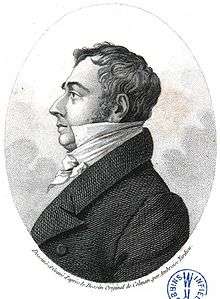Jean Vincent Félix Lamouroux
Jean Vincent Félix Lamouroux (3 May 1779 – 26 March 1825) was a French biologist and naturalist, noted for his seminal work with algae.
Jean Vincent Félix Lamouroux | |
|---|---|
 Jean Vincent Félix Lamouroux | |
| Born | May 3, 1779 Agen |
| Died | March 26, 1825 (aged 45) Caen |
| Nationality | French |
| Education | Saint-Amans school |
| Known for | Seminal work with algae |
| Scientific career | |
| Fields | Biology |
| Thesis | (1805) |
| Notable students | Arcisse de Caumont |
| Author abbrev. (botany) | J.V.Lamour. |
Biography
Lamouroux was born in Agen in the Aquitaine of southwestern France, the son of Claude Lamouroux, an intellectual who made his livelihood in manufacturing, but who was also a musician, a one-term mayor of Agen, and a co-founder of the Academic Society of Agen. Jean Vincent Lamouroux studied botany at the Boudon de Saint-Amans school in Agen.
Lamouroux was particularly interested in marine organisms such as algae and hydrozoans. In 1805 he published a dissertation on several species of Fucus[1] before settling in Paris in 1807, after his father went into bankruptcy.
In 1807, Lamouroux was appointed to the French Academy of Sciences and in 1808 he became assistant professor of natural history at the University of Caen, rising to full professorship by 1811. He joined the Linnean Society of Calvados and contributed to its publications, collaborating with his friend Jean Baptiste Bory de Saint-Vincent. About this time he became director of the Caen Botanical Gardens. He contributed articles to the journal Annales générales des sciences physiques ("General Annals of the Physical Sciences")[2] and to the Dictionnaire classique d'histoire naturelle (Classic Dictionary of Natural History).[3]
Lamouroux was the first to make the distinction between green algae, brown algae and red algae. In 1813, Dawson Turner adopted Lamouroux's classification system for algae, providing it with international credence.
Lamouroux was also interested in other classification systems in marine biology. On which he published two notable works:
- Histoire des Polypiers coralligènes flexibles, vulgairement nommés Zoophytes (Origin of the flexible coralline polypbearers, popularly named zoophytes) (1816) Caen
- Exposition méthodique des genres de l'ordre des polypiers (Systematic description of the genera of the order of polypbearers) (1821) Paris.
In 1821 he published a "Résumé d’un cours élémentaire de géographie physique" ("Summary of a basic course of physical geography")[4] exploring the foundations of atmospheric science, hydrography, astronomy, and geology. Lamouroux's interest in fossils was quite broad. He collected reptilian fossils in the Jurassic of Normandy and communicated some of them to Georges Cuvier.
In 1825, Lamouroux died in Caen. He was most influential on his student Arcisse de Caumont, who succeeded him in his chair at the University of Caen.
Species
Among the species that Lamouroux identified and described are:
|
|
|
He also described genera such as Desmarestia.[6]
Notes
- Dissertations sur plusieurs espèces de fucus, peu connues ou nouvelles, avec leur description en Latin et en Français OCLC 287240318
- Annales générales des sciences physiques OCLC 287058728
- Dictionnaire classique d'histoire naturelle OCLC 557936846
- Résumé d'un cours élémentaire de Géographie physique OCLC 422305533; revised in 1826 OCLC 561716710
- IPNI. J.V.Lamour.
- Lamouroux, Jean Vincent Félix (1813). "Essai sur les genres de la famille des thalassiophytes non articulées" (PDF). Annales du Muséum d'Histoire Naturelle, Paris (in French). Paris: G. Dufour et cie. 20: 43–45. OCLC 2099267. Retrieved 11 December 2017.
Sources
- Brignon, Arnaud (2014) "The first discoveries of fossil crocodilians in the “Pierre de Caen” (Bathonian, Normandy, France) through the archives of Georges Cuvier", Revue de Paléobiologie, 33(2):379-418
- Ferrière, Hervé (2009) "Bory de Saint-Vincent: l'évolution d'un voyageur naturaliste" (Bory de Saint-Vincent: the evolution of a traveling naturalist) Syllepse, Paris, France, ISBN 978-2-84950-243-3
- Lauzun, Philippe (1893) "Une famille agenaise: Les Lamouroux" de Vve Lamy, Agen, France, OCLC 123524904
External links
| Wikispecies has information related to Jean Vincent Félix Lamouroux |
| Wikimedia Commons has media related to Jean Vincent Félix Lamouroux. |